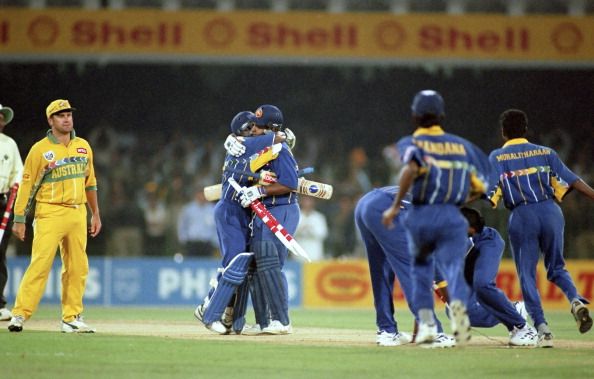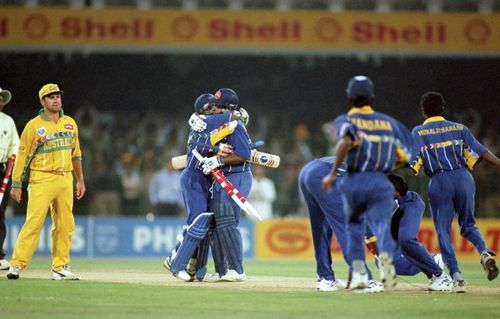
How the Cricket World Cup can have more ebbs and flows

Thrill caused by upsets in previous World Cups
The greatest contribution of the 1996 Cricket World Cup was the emergence of Sri Lanka on the biggest stage of cricket. Although Sri Lanka were not minnows coming into the tournament, not many pundits would have tipped them to finish as the winners.
Just like the United States of America were baffled by the guerrilla warfare of Vietnam in the USA-Vietnam war, the world was shell shocked by the chutzpah of Sri Lankan cricket in that World Cup. Nobody could fathom how to tackle the tactical shrewdness of their captain Arjuna Ranatunga.
The ballistic opening pair of Sanath Jayasuriya and Romesh Kaluwitharana were at their belligerent best throughout the tournament and Aravinda de Silva played the likes of Glenn McGrath, Shane Warne and Damien Fleming in the final like he was having a knock in his backyard. His dominance in the final was a sight never seen before. A hundred combined with three wickets, including that of Ricky Ponting, made for a performance worth its weight in gold.
If Ireland had not participated in the 2011 World Cup, we would not have witnessed one of the best World Cup innings ever. Kevin O'Brien, coming in at 106/4, played the innings of his life and when he was dismissed, Ireland were at the cusp of victory at 317/7. It was an innings full of audacious strokeplay with 6 sixes and 13 fours which caught England napping.
Another epic upset by Ireland was in the 2007 World Cup against Pakistan. Fittingly, played on St. Patrick’s Day, Ireland defeated the 1992 champions by three wickets to qualify for the Super 8 stage and sent Pakistan home. In the same World Cup, India were sent crashing out of the tournament by an upset inflicted by Bangladesh.
India were also surprised in the 1999 World Cup by Zimbabwe as Henry Olonga took the match out of India's hand by picking up three wickets in six balls to set up an epic victory.
World Cup format can be made more interesting
Even before the 2015 Cricket World Cup has started, cricket aficionados are sure of the teams which will reach the quarterfinal stage. Comparing this scenario to the most popular sport in the world, the FIFA World Cup 2014 saw four out of the eight quarterfinalists not among the top eight ranked teams in the world before the tournament started.
The extent of competition in football is visible from the fact that teams like Italy, Spain and England were knocked out in the first stage of the tournament and the Golden Boot went to James Rodriguez, a player from Colombia, who were ranked eighth in the FIFA rankings before the World Cup. This uncertainty keeps the fans on the edge of their seats and sends out a message to the high profile teams that they have their work cut out.
As Rahul Dravid and Graeme Smith recently opined, the current format of the Cricket World Cup is lengthy as it has a total of 49 matches over 44 days. Now, my suggestion is that we can have three groups of five teams each in the round robin stage. So the number of matches in the initial stage amounts to only 30. With two teams qualifying from each group, only six teams would make the next stage.
Now, in the second stage, we have two groups of three teams each and a total of 6 matches to decide the semifinalists. In this format, we can accommodate 15 teams (current format has 14 teams) and still reduce the total number of matches to 39. Another advantage of this format is that at any stage we are not sure of the teams progressing to the next stage, thus, maintaining the suspense a tournament like the World Cup should have.
Associate teams need more exposure
The six least fancied nations in the ICC World Cup 2015 are Bangladesh, Zimbabwe, Ireland, Afghanistan, Scotland and UAE. If we have a look at all these six lesser fancied nations, then there are three or four good players in each of them and the remaining team tends to work around them. So when these players have a good day, their fans are in for a treat, but on other days their performances are shambolic.
The best way to increase competition in cricket is to allow the associate nations to play more matches with the bigger nations in cricket as they can hone their skills in that way. Another thing to keep in mind here is that an epic win by a less fancied team on a big stage like the World Cup can galvanize the whole nation, which is what happened in India in 1983 when they triumphed over the mighty West Indies. This is why ICC’s idea of having the World Cup 2019 as a tournament with lesser teams is debatable.
As is the case with democracy, the higher the number of parties present, lesser is the dominance of a single party. Similarly, the increase in competition in cricket would reduce the dominance by a single nation on the game. Maybe soon, the performance of O'Brien against England in the 2011 World Cup will not be considered an aberration and would come in the knockout stage of the tournament rather than the round robin stage.